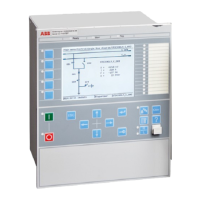IEC07000199-2-en.vsd
SMAI1:13
BLOCK
DFTSPFC
^GRP1L1
^GRP1L2
^GRP1L3
^GRP1N
SPFCOUT
AI3P
AI1
AI2
AI3
AI4
AIN
SMAI1:1
BLOCK
DFTSPFC
^GRP1L1
^GRP1L2
^GRP1L3
^GRP1N
SPFCOUT
AI3P
AI1
AI2
AI3
AI4
AIN
SMAI1:25
BLOCK
DFTSPFC
^GRP1L1
^GRP1L2
^GRP1L3
^GRP1N
SPFCOUT
AI3P
AI1
AI2
AI3
AI4
AIN
IEC07000199 V3 EN-US
Figure 217: Configuration for using an instance in task time group 2 as DFT reference.
Assume instance SMAI4:16 in task time group 2 has been selected in the configuration to
control the frequency tracking for all instances. Observe that the selected reference instance
(i.e. frequency tracking master) must be a voltage type. Observe that positive sequence
voltage is used for the frequency tracking feature.
For task time group 1 this gives the following settings (see Figure
215 for numbering):
SMAI1:1 – SMAI12:12:
DFTReference
=
ExternalDFTRef
to use DFTSPFC input as reference
(SMAI4:16)
For task time group 2 this gives the following settings:
SMAI1:13:
DFTRefExtOut
=
DFTRefGrp4
to route SMAI4:16 reference to the SPFCOUT output,
DFTReference
=
DFTRefGrp4
for SMAI1:13 to use SMAI4:16 as reference (see Figure 217)
SMAI2:14 – SMAI12:24:
DFTReference
=
DFTRefGrp4
to use SMAI4:16 as reference.
For task time group 3 this gives the following settings:
SMAI1:25 – SMAI12:36:
DFTReference
=
ExternalDFTRef
to use DFTSPFC input as reference
(SMAI4:16)
21.12 Test mode functionality TEST
IP1647-1 v2
21.12.1 Application
M11407-3 v8
The protection and control IEDs may have a complex configuration with many included
functions. To make the testing procedure easier, the IEDs include the feature that allows
individual blocking of a single-, several-, or all functions.
This means that it is possible to see when a function is activated or trips. It also enables the
user to follow the operation of several related functions to check correct functionality and to
check parts of the configuration, and so on.
1MRK 511 358-UEN A Section 21
Basic IED functions
451
Application manual

